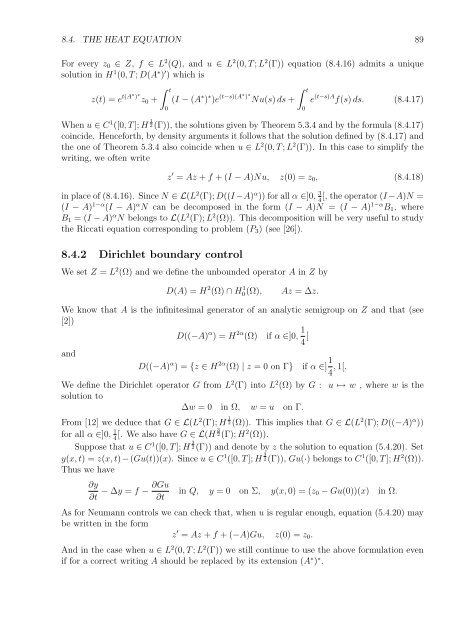Optimal Control of Partial Differential Equations
Optimal Control of Partial Differential Equations
Optimal Control of Partial Differential Equations
Create successful ePaper yourself
Turn your PDF publications into a flip-book with our unique Google optimized e-Paper software.
8.4. THE HEAT EQUATION 89<br />
For every z0 ∈ Z, f ∈ L 2 (Q), and u ∈ L 2 (0, T ; L 2 (Γ)) equation (8.4.16) admits a unique<br />
solution in H1 (0, T ; D(A∗ ) ′ ) which is<br />
t<br />
z(t) = e t(A∗ ) ∗<br />
z0 +<br />
0<br />
(I − (A ∗ ) ∗ )e (t−s)(A∗ ) ∗<br />
Nu(s) ds +<br />
t<br />
0<br />
e (t−s)A f(s) ds. (8.4.17)<br />
When u ∈ C 1 ([0, T ]; H 1<br />
2 (Γ)), the solutions given by Theorem 5.3.4 and by the formula (8.4.17)<br />
coincide. Henceforth, by density arguments it follows that the solution defined by (8.4.17) and<br />
the one <strong>of</strong> Theorem 5.3.4 also coincide when u ∈ L 2 (0, T ; L 2 (Γ)). In this case to simplify the<br />
writing, we <strong>of</strong>ten write<br />
z ′ = Az + f + (I − A)Nu, z(0) = z0, (8.4.18)<br />
in place <strong>of</strong> (8.4.16). Since N ∈ L(L2 (Γ); D((I −A) α )) for all α ∈]0, 3[,<br />
the operator (I −A)N =<br />
4<br />
(I − A) 1−α (I − A) αN can be decomposed in the form (I − A)N = (I − A) 1−αB1, where<br />
B1 = (I − A) αN belongs to L(L2 (Γ); L2 (Ω)). This decomposition will be very useful to study<br />
the Riccati equation corresponding to problem (P3) (see [26]).<br />
8.4.2 Dirichlet boundary control<br />
We set Z = L 2 (Ω) and we define the unbounded operator A in Z by<br />
D(A) = H 2 (Ω) ∩ H 1 0(Ω), Az = ∆z.<br />
We know that A is the infinitesimal generator <strong>of</strong> an analytic semigroup on Z and that (see<br />
[2])<br />
D((−A) α ) = H 2α (Ω) if α ∈]0, 1<br />
4 [<br />
and<br />
D((−A) α ) = {z ∈ H 2α (Ω) | z = 0 on Γ} if α ∈] 1<br />
, 1[.<br />
4<br />
We define the Dirichlet operator G from L2 (Γ) into L2 (Ω) by G :<br />
solution to<br />
u ↦→ w , where w is the<br />
∆w = 0 in Ω, w = u on Γ.<br />
From [12] we deduce that G ∈ L(L 2 (Γ); H 1<br />
2 (Ω)). This implies that G ∈ L(L 2 (Γ); D((−A) α ))<br />
for all α ∈]0, 1<br />
4<br />
[. We also have G ∈ L(H 3<br />
2 (Γ); H 2 (Ω)).<br />
Suppose that u ∈ C 1 ([0, T ]; H 3<br />
2 (Γ)) and denote by z the solution to equation (5.4.20). Set<br />
y(x, t) = z(x, t)−(Gu(t))(x). Since u ∈ C 1 ([0, T ]; H 3<br />
2 (Γ)), Gu(·) belongs to C 1 ([0, T ]; H 2 (Ω)).<br />
Thus we have<br />
∂y<br />
∂t<br />
− ∆y = f − ∂Gu<br />
∂t<br />
in Q, y = 0 on Σ, y(x, 0) = (z0 − Gu(0))(x) in Ω.<br />
As for Neumann controls we can check that, when u is regular enough, equation (5.4.20) may<br />
be written in the form<br />
z ′ = Az + f + (−A)Gu, z(0) = z0.<br />
And in the case when u ∈ L 2 (0, T ; L 2 (Γ)) we still continue to use the above formulation even<br />
if for a correct writing A should be replaced by its extension (A ∗ ) ∗ .

















